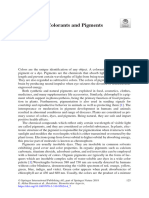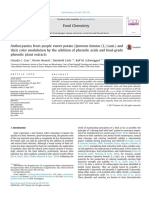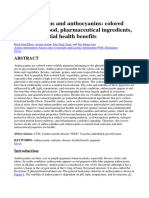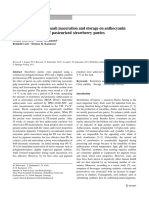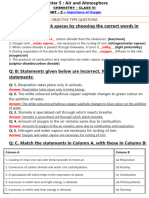Research 1 - Food Colors
Research 1 - Food Colors
Uploaded by
WasimCopyright:
Available Formats
Research 1 - Food Colors
Research 1 - Food Colors
Uploaded by
WasimCopyright
Available Formats
Share this document
Did you find this document useful?
Is this content inappropriate?
Copyright:
Available Formats
Research 1 - Food Colors
Research 1 - Food Colors
Uploaded by
WasimCopyright:
Available Formats
Pharmaceutical Resonance 2020 Vol.
2 - Issue 2
REVIEW ARTICLE
A REVIEW ON NATURAL FOOD COLORS
Reshma V. Jadhav*, Santosh S. Bhujbal
Dr. D. Y. Patil Institute of Pharmaceutical Sciences and Research, Pimpri, Pune - 411 018
ABSTRACT:
Consumer demand for natural colors is enhanced as awareness about various toxicities of synthetic food colors.
Natural plant colorants have been in high demand by the food industry for replacing synthetic colors. Many
approved synthetic food colorants like quinoline Yellow, carmoisine, tartrazine have been prohibited as they
proved to be toxic. Plant is huge source of natural colors like caretonoids, chlorophyll, anthocyanins and betalains
which proved to be alternatives to synthetic colorants. However, replacing synthetic colors with natural colorants
offers a challenge due to the higher stability of synthetic colors towards light, oxygen, temperature, and pH,
among other factors. Stabilization of natural pigments is the main challenge to overcome for their utilization as
food colorants. To overcome these pitfalls the emerging techniques like hydrocolloid complexation, metal
complexation, microencapsulation, intermolecular and intramolecular copigmentation have been developed to
enhance stability of natural food colors.
Keywords : Anthocyanins, carotenoids, chlorophylls, batalains.
1. Introduction benefits [5]. Nowdays the role of natural colors as
food colorant is becoming increasingly important.
Color is an important factor increasing consumer’s They contribute to the most important attributes of
acceptability to food products. This is due to food both for aesthetic value and for quality
consumers always links food color with other evaluation but also they tend to give potential health
qualities such as ripeness, freshness, and food safety. effects, as they have been observed to possess potent
Thus, many food products have added food colorants antioxidant activities. The expenditure in natural food
to make the food products more desirable and color market across the globe has reached to US $ 1
acceptable [1]. The synthetic food colors are billion and is constantly increasing 10 % annually
available in different c o l o r shades. There are [6].
many reports on the toxicity of synthetic colors.
Approved synthetic colors are proved to be toxic and Nature gives a number of compounds adequate for
carcinogenic [2]. This need has come from legislative food coloring, such as the water soluble
action and consumer orientation against synthetic anthocyanins, betalains, as well as the oil soluble
food colors [3]. The usage of large amount of carotenoids and chlorophylls. However, substituting
synthetic colors causes pollution, disturbs the synthetic colors with natural colorants presents a
ecological balance and causes health hazards to challenge because the color and stability of plant
human. Natural colors are obtained from naturally pigments are dependent on various factors like
occurring sources such as plants, animals, insects, structure and concentration of the pigment, light
and minerals [4]. Amongst the all natural colors, intensity, metals, pH, temperature, enzymes, oxygen,
plant based pigments have wide range of medicinal ascorbic acid, sugars [7], flexibility during
processing, long lasting effect, profitability.
Synthetic colorants are more favorable from all this
point of view [8].
Ramesh V. Jadhav
Dr. D. Y. Patil Institute of The natural colorants are ecofriendly, harmonized
Pharmaceutical Sciences and Research with nature, obtained from renewable sources and
Sant Tukaram Nagar, Pimpri, Pune - 411 018 their method of preparation involves minimum
Email : khopade.reshma@rediffmail.com possibility of chemical reactions and they are
Contact : +00 00000 00000 biodisposable [9]. Because of the pitfalls of existing
natural food colorants, the demand for natural
© Published by DYPIPSR, Pimpri, Pune - 411 018 ( MH ) INDIA 12
Pharmaceutical Resonance 2020 Vol. 2 - Issue 2
colorants is continuously increased by the food Betalains is comparatively stable over the broad pH
processing industries. This need can be fulfilled by range from 3 to 6, which allows their incorporation in
research to offer a more natural and healthier way of low acidic foods. Below pH 3.5, the absorption
coloring foods. Thereby, plant pigment research is maxima shifts toward lower wavelengths, and above
looking new sources of pigments [10]. Food color pH 7 the shift is towards upper ones. Optimal pH
manufacturers therefore striving to develop new range for maximum betalain stability is 5–6. Alkaline
technologies to meet customer demands [4]. conditions results in aldimine bond hydrolysis, while
acidification produces recondensation of betalamic
2. Plant natural colors: acid with the amine group of the addition residue.
The natural colorants in natural plants have been the The storage of betanin solutions under low oxygen
source of the traditional colorants of raw as well as levels results in reduced pigment degradation than
the processed food. under air atmosphere. Betalain light induced
degradation is oxygen dependent, because the effects
Table 1 : Plant Natur al Colour of light exposure are insignificant under anaerobic
conditions. Temperature is the foremost affecting
Class Color E -number factor on betalain stability during food processing
and storage. Some studies reported increasing
Chlorophyll Olive green E 140 betalain degradation rates resulting from increase in
temperatures. During heat processing, betalain may
Red, purple, blue, be degraded by isomerisation, decarboxylation or
Anthocyanins E 163 cleavage results in a gradual decline of red color, and
pink, magenta
eventually the formation of a light brown color [15].
Carotenoids Red, orange, yellow E 160 Hence, these pigments have potential to be used as
colorants in frozen foods, low temperature dairy
products and short shelf life food products [16].
Betalains Red, yellow E 162
Betalains can be stabilized to a definite extent by
2.1 Betalains: antioxidants, such as ascorbic acid , isoascorbic acid,
citric acid, and other preservatives, whereas
Betalains are water-soluble, nitrogen containing plant antioxidant phenolic molecules have no stabilization
pigments present in most plants of the order effect on the pigments [17]. To enhance the stability
Caryophyllales. Betalains are distributed not only in of betalains, blanching is usually done to inactivate
edible parts of plants but also in flowers, leaves, stem the betacyanin decoloring enzyme, which tends to
and bracts. These are classified into two color fading [18]. Betalain stability was improved
groups,violet betacyanins and the yellow when combined with b-cyclodextrin probably due to
betaxanthins. Both groups shared betalamic acid as the formation of a 1:1 inclusion complex [19].
the structural and chromophoric unit. Betalamic acid
is condensed with amines and amino acids in Examples of plants containing betalains:
betaxanthins and with cyclo-DOPA in betacyanins.
Table 2 : Plants containing Betalains
Betanidin is the aglycone of most betacyanins;
different substitution like glycosylation and acylation Betacyanins Betaxanthins
patterns of one or both hydroxyl groups located at
position 5 or 6 of betanidin result in the formation of
Beta vulgaris Mirabilis jalapa
the various betacyanins. Most of these are 5-O-
(Amaranthaceae) (Nyctaginaceae)
glucosides, and rarely are 6-O glucosides [11].
Glycosylation of the 5-O-glucoside is very common Amaranthus caudatus Portulaca grandiflora
and so is esterification with hydroxycinnamic acids. (Amaranthaceae) (Portulacaceae)
The most common betacyanin is betanidin-5-O-
glycoside called as betanin, the major pigment in red Gomphrena globosa Opuntia ficus-indica
beet roots [12]. All betalains manifest absorption (Amaranthaceae) (Cactaceae)
maxima in both UV and visible regions due to the Bougainvillea glabra Stenocereus pruinosus
phenolic nature of betalamic acid and the conjugated (Nyctaginaceae) (Cactaceae)
dienes of 1,7-diazaheptamethin substructure,
respectively [13]. However, these pigments are prone 2.2 Chlorophyll:
to different physicochemical factors, such as light, Chlorophylls are oil soluble and the most widespread
heat, high pH (>6), air and various metals [14]. distributed pigments responsible for the
© Published by DYPIPSR, Pimpri, Pune - 411 018 ( MH ) INDIA 13
Pharmaceutical Resonance 2020 Vol. 2 - Issue 2
Fig. 1 : Degr adation r eactions of Betalains in food
Characteristic green color of plants [20]. The reason of changing of the chlorophylls color from
structure of chlorophylls is porphyrins or tetrapyroles green to olive brown. These changes occurs due to
chelated with a centrally located magnesium atom. the loss of central magnesium atom in the
The main chlorophylls in foods are chlorophyll a and chlorophylls structure, with the substitution of
chlorophyll b. These chlorophylls are different at hydrogen ions, leading to the transformation of the
position 7, where chlorophyll a contains –CH3 and chlorophylls structure from native chlorophylls to
chlorophyll b contains –CHO. This difference leads pheophytin, which manifest olive brown color
to the difference in their color; chlorophyll a appears [23].Other enzymes such as chlorophyllase and
blue-green, while chlorophyll b have yellow-green oxidative enzymes like lipoxygenase, chlorophyll
color [21]. oxidase and peroxidase are also responsible for
chlorophylls degradation and cause color change
Chlorophylls are highly sensitive to heat, light, [20].
oxygen, acids and enzymes, leading to their prompt
degradation and color change. They are stable in Enzymes and acids are the major factors affecting the
alkaline pH between 7-9. It is unstable in acidic pH. degradation of chlorophylls thus, enhancing the
When exposed to light or heat, the cell membrane of stability of chlorophylls pigments can be done by
the plant degenerate releasing acids which decrease inactivating the enzymes or preventing an acidic
the pH [22]. Acids and Mg-dechelatase, which is an condition. Blanching is a short time thermal
enzyme found in algae and plants, are the main treatment, which is usually done by exposing a
© Published by DYPIPSR, Pimpri, Pune - 411 018 ( MH ) INDIA 14
Pharmaceutical Resonance 2020 Vol. 2 - Issue 2
sample to hot water or steam, to inactivate enzymes agents (e.g., butylated hydroxyanisol, pyrogallol and
involving in the change of color of plant materials citric acid) are proposed to prevent pigment
[24]. Complexation of chlorophylls into metal degradation by oxidation [29].
complexes of chlorophyll derivatives e.g., copper
pyropheophytin and zinc pyropheophytin has been Inspite of adding acid-based antioxidants leads to a
proposed to alleviate the above problems. decrease in the pH of a sample; when the pH of a
Chlorophylls can be transformed into metallo- sample becomes less than 3.0, carotenoids would
chlorophyll derivatives, which display green color start to decompose. The pH of a sample should be
like native chlorophylls but having more stability to particularly controlled when acid-based antioxidants
acids and heat. Although both copper and zinc ions such as organic acids are used [30].
can be used for metallochlorophyll derivatives 2.4 Anthocyanins:
formation, zinc ions are of greater interest due to the
toxicity of copper ions [20]. Anthocyanins are water soluble plant pigments. They
are responsible for the blue, purple, red and orange
colors of many fruits and vegetables [31]. They occur
mainly as glycosides of their respective aglycone
anthocyanidin chromophores with the sugar moiety
generally attached at the 3-position on the C-ring or
the 5- position on the A-ring. Only six antocyanidin
are common namely, cyanidin, delphinidin,
petunidin, peonidin, pelargonidin, and malvidin
which are widely spread and of great importance in
human diet and health. The array of anthocyanins are
due to the number and position of hydroxyl and
Fig. 2 : Str uctur e of chlor ophyll methoxy groups on the basic anthocyanidin skeleton.
If hydroxyl groups predominate, then the color goes
2.3 Carotenoids: toward a more bluish shade; if more methoxyl groups
predominate, then redness is increased.
Carotenoids are plant pigments with 40 carbon atoms
molecule. Carotenoids have provitamin A activity The color stability of anthocyanins is affected not
because the body can convert them into retinol [25]. only by the structural features, but also by the pH,
Carotenoids are lipid soluble, yellow–orange red temperature, light, presence of co-pigments,
pigments found in all higher plants and some enzymes, oxygen and sugars. In a high acidic media
animals. Carotenoids can be classified into carotenes the red flavylium cation is the only predominating
containing only carbon and hydrogen, and equilibrium species. Increasing the pH results in
xanthophylls made up of carbon, hydrogen, and decrease of both the color intensity and the
oxygen. It is more stable at pH between 4.0 and 6.0. concentration of the flavylium cation, as it is
Degradation of carotenoids is mainly occurs due to hydrated by nucleophilic attack of water, to the
reactions of oxidation and isomerization, which tend colorless carbinol form. The carbinol form has lost
to a decrease in the redness and yellowness of a plant its conjugated double bond between the A and B ring
pigments [26]. and therefore does not absorb visible light . Also a
rapid proton loss of the flavylium cation takes place
There are various factors affecting the oxidation and as the pH shifts higher and the colored quinonoidal
isomerization of carotenoids. Oxygen causes form rises. When pH increases further, the carbinol
oxidation of carotenoids; the reaction can also be form yields, through ring opening, the colorless
raised by light, heat, peroxide, metal ions and chalcone [32].
enzymes [27]. Most carotenoids in plants are trans-
isomer, while isomerization of the trans-isomer to cis Heat is another an important factor affecting the color
-isomers occurs during food processing [28]. and stability of natural pigments. However,
Inactivation of oxidative enzymes is among the anthocyanins are more stable to heat than the
possible way to prevent carotenoids oxidation. Hot pigments. Degradation of anthocyanins occurs when
water or steam blanching is a simple pretreatment temperature approaches 100 °C or even higher [33].
method that can be utilized to inactivate enzymes The first step of thermal degradation involves the
such as lipoxygenase, which catalyzes oxidative formation of colorless carbinol pseudobase and
decomposition of carotenoids. Chemical subsequent opening of the pyrylium ring to form
pretreatments are another alternative method to chalcone, before converting into a brown degradation
prevent the oxidation of carotenoids. Antioxidant product [34].
© Published by DYPIPSR, Pimpri, Pune - 411 018 ( MH ) INDIA 15
Pharmaceutical Resonance 2020 Vol. 2 - Issue 2
Table 3 : Plant sour ces of car otenoids
Caretonoids Food sources
Buriti (Mauritia vinifeva), carrot,
α-carotene
Cucurbita moschata, red palm oil
Carrot, acerola (Malpighia glabra),
apricot, bocaiava (Acronomia
makayliyba), broccoli, buriti,
cantaloupe, carrot, Cucurbita
maxima, Cucurbita moschata,
β-carotene green leafy vegetables, mamey
(Mammea Americana), mango,
peach palm (Bactris gasipaes),
Fig. 3 : Degr adation r eactions of chlor ophyll in pink grapefruit, red palm oil, red
foods pepper, yellow and orangefleshed
sweet potato, tucum5 (Astrocayum
vulgare)
Caja (Spondias lutea), pitanga
β-
(Eugenia uniflora), red pepper,
cryptoxanthin
tree tomato (Cyphomandra
betacea)
Pink grapefruit, pink-fleshed
lycopene guava, red-fleshed papaya, pitanga
(Eugenia uniJora), tomato,
watermelon , tomato
Green leafy vegetables, broccoli,
Lutein
Brussels sprout, corn, Cucurbita
maxima
zeaxanthin Buriti, corn
Fig. 4 : Str uctur e of common car otenoids In addition to a proper pH adjustment, the source of
anthocyanins must be considered to obtain the most
stable colorant. Different sources of plant materials
contain different anthocyanins structure, which affect
their stability. Anthocyanins from red cabbage, black
carrot, red radish and red sweet potato are reported to
be more stable to heat and pH change than
anthocyanins from other sources due to their
acylation. Acylation of the anthocyanin molecules
can enhance the stability through intramolecular
copigmentation. Higher stability of acylated
anthocyanins is due to the stacking of acyl group with
the pyrylium ring of the flavalium cation, thus
retarding the nucleophile attack of water and
subsequent formation of chalcone. Many researchers
have indeed reported the stability of acylated
anthocyanins as compared with that of nonacylated
Fig. 5 : Degradation reaction of carotenoids in foods anthocyanins [35].
© Published by DYPIPSR, Pimpri, Pune - 411 018 ( MH ) INDIA 16
Pharmaceutical Resonance 2020 Vol. 2 - Issue 2
Table 4 : Common anthocyanins and their
associated colors
Anthocyanin Color
Pelargonidin Orange
Cyanidin Red
Delphinidin Blue
Peonidin Reddish purple
Malvidin Voilet
Petunidin Purple Fig. 6 : Structure of common anthocyanins
Table 5 : Common sour ces of anthocyanins
Plants containing Anthocyanins:
Plant Anthocyanidins
Apple, red cabbage, peach, rasberry Cyanidin
Black current Cyanidin , delphinidin
Cherry,plum Cyanidin, peonidin
Red radish Pelargonidin
Blueberry Cyanidin,delphinidin, peonidin, malvidin
Strawberry Pelargonidin, cyanidin
Grape Malvidin, peonidin, delphinidin, cyanidin, pelargonidin
Fig. 7 : pH behavior of Anthocyanins
© Published by DYPIPSR, Pimpri, Pune - 411 018 ( MH ) INDIA 17
Pharmaceutical Resonance 2020 Vol. 2 - Issue 2
Fig. 8 : Degradation reaction of anthocyanin in foods
Conclusion Nutrition and Food Science. 2014; 3(3): 145-
156.
Color is the main feature of any food item as it
enhances the appeal and acceptability of food. [3] Var, A., Cevallos-Casals., Zevallos LC. Stabil
Although worldwide possesses large plant resources, ity of anthocyanin-based aqueous extracts of
only little has exploited so far. Natural colors are Andean purple corn and red-fleshed sweet pota
highly unstable with various food processing to compared to synthetic and natural colorants.
conditions. Stabilization of natural pigments is the Food Chemistry. 2004; 86: 69–77.
main challenge to overcome for their utilization as
food colorants. Thus, more detailed studies and [4] Meena Devi, VN., Ariharan VN., Nagendra PP.
scientific investigations are needed to assess the real Annato: Ecofriendly and potential source for
potential and availability of natural dye-yielding natural dye. International Research Journal of
resources. The food industry that develops and Pharmacy. 2013; 4(6):106-108.
manufactures natural food colors is growing [5] Scotter MJ. Emerging and persistent issues
exponentially as a result of consumer demands for with arti¢cial food colours: natural colour addi
natural pigments in lieu of synthetic colorants. tives as alternatives to synthetic colours in food
References: and drink. J. Quality Assurance and Safety of
Crops & Foods. 2011; 3:28-39.
[1] Duangmal, K., Saicheua, B., Sueeprasan, S. Ro
selle anthocyanins as a natural food colorant [6] Tsai, PJ., McIntosh, J., Pearce, P., Camden, B.,
and improvement of its color stability. AIC Jordan TB. Anthocyanin and antioxidant capac
Color and Paints, Interim Meeting of the Inter ity in roselle (Hibiscus Sabdariffa L.) extract.
national Color Association. 2004; 155-158. Food Research International. 2002; 35: 351-
356.
[2] Ozkan, G., Bilek, SE. Microencapsulation of
natural food colorants. International Journal of [7] Reshmi, SK., Arvindhan, KM. The effect of
Light, Temperature, p H on stability of on the
© Published by DYPIPSR, Pimpri, Pune - 411 018 ( MH ) INDIA 18
Pharmaceutical Resonance 2020 Vol. 2 - Issue 2
stability of Betacyanin pigments in Basella A l and γ-cyclodextrins. B.CEPPA. 2006; 24
ba fruits. Asian Journal of Pharmaceutical and (1):259–276.
Clinical Research. 2012; 5(4): 107-110.
[20] Levent İnanc, A. Chlorophyll: Structural Prop
[8] Eva Nemeth. Colouring plants. Encyclopedia of erties, Health Benefits and Its Occurrence in
Life Support Systems, 1-6. Virgin Olive Oils. Academic Food Journal.
2011; 9(2): 26-32.
[9] Joshi, P., Jain, S., Sharma V. Acceptability as
sessment of yellow color obtained from turmer [21] Steet, JA., Tong, CH. Degradation kinetics of
ic in food products and at consumer level. J. green color and chlorophylls in peas by color
Food Ag-Ind. 2011; 4(1) : 1-15. imetry and HPLC. J Food Sci. 1996; 61: 924-
928.
[10] Agrawal A. Scope of Betalains as a food color
ants. International journal of advanced scien [22] Ozkan, G., Bilek, SE. Enzyme-assisted extrac
tific and technical research. 2013; 3(3): 22-36. tion of stabilized chlorophyll from spinach.
Food Chem. 2015; 176: 152–157.
[11] Delgado-Vargas, F., Jimenez, AR., Paredes-
Lopez, O. Natural pigments: carotenoids, an [23] Attoe, EL., Von Elbe, J H. Photochemical deg
thocyanins, and betalains - characteristics, bio radation of betanine and selected anthocyanins.
synthesis, processing, and stability. Critical Re J. Food Sci. 1981; 46: 1934–1937.
views in Food Science and Nutrition. 2002; 40:
173–289. [24] Bahceci, KS., Serpen, A., Gokmen ., Acar, J.
Study of lipoxygenase and peroxidase as indi
[12] Stintzing, FC., Carle, R. Functional properties cator enzymes in green beans: Change of en
of anthocyanins and betalains in plants, food, zyme activity, ascorbic acid and chlorophylls
and in human nutrition. Trends in Food Science during frozen storage. J Food Eng. 2005; 66:
and Technology. 2004; 15: 19–38. 187–192.
[13] Gand-Herrero, F., Jim enez-Atienzar, M., [25] Khachik, F. Distribution and metabolism of di
Cabanes, J., Garc-Carmona, F., Escribano J. etary carotenoids in humans as a criterion for
Stabilization of the bioactive pigment of Opun development of nutritional supplements. 14th
tia fruits through maltodextrin encapsulation. J. International Symposium on Carotenoids. 2006;
Agric. Food. Chem. 2010; 58:10646–10652. 78:1551-1557.
[14] Herbach, KM., Stintzing, FC., Carle R. Betalain [26] Provesi, JG., Amante, ER. Changes in carote
stability and degradation—structural and chro noids during processing and storage of pump
matic aspects. Journal of Food Science. 2006; kin puree. Food Chemistry. 2011; 128: 195–
71:41–50. 202.
[15] Henriette, MC., Azeredo. Betalains: properties, [27] Boon, CS., McClements, DJ., Weiss, J., Deck
sources, applications, and stability – a review. er, EA. Factors influencing the chemical stabil
International Journal of Food Science and ity of carotenoids in foods. Crit Rev Food Sci
Technology. 2009; 44: 2365–2376. Nutr. 2010; 50: 515–532.
[16] Altamirano, RC., Drdak, M. Simon, P., Rajnia [28] Khoo, HE., Prasad, KN., Kong, KW., Jiang, Y.,
kova, A., Karovicova, J., Preclík L. Thermal Ismail A. Carotenoids and their isomers: Color
degradation of betanine in various water alco pigments in fruits and vegetables. Molecules.
hol model systems, Food Chem. 1993; 46: 73– 2011; 16: 1710–1738.
75.
[29] Otles S, Agindi. Carotenoids as natural color
[17] Khan MI. Stabilization of betalains: A review. ants. In Socaciu C, eds. Food Colorants: Chem
Food Chemistry .2016; 197: 1280–1285. ical and Functional Properties, 1st ed., New
York : Boca Raton publishers.; 2008: 51–70.
[18] Delgado-Vargas, F., Paredes- Lopez, O. Natu
ral Colorants for Food and Nutraceutical Uses. [30] Qian, C. Decker, EA., Xiao, H., McClement,
2003; CRC Press, Boca Raton. DJ. Physical and chemical stability of β- caro
tene-enriched nanoemulsions: Influence of pH,
[19] Drunkler, DA., Fett, R., Bordignon Luiz, MT. ionic strength, temperature, and emulsifier type.
The evaluation of stability of betalains in beet Food Chem. 2012; 132: 1221–1229.
root (Beta vulgaris L.) extract addition of α, β
© Published by DYPIPSR, Pimpri, Pune - 411 018 ( MH ) INDIA 19
Pharmaceutical Resonance 2020 Vol. 2 - Issue 2
[31] Mazza GJ. Anthocyanins and heart health. Ann.
Ist. Super. Sanita. 2007; 43: 369-374.
[32] Miguel MG. Anthocyanins: Antioxidant and/or
anti-inflammatory Activities. Journal of Ap
plied Pharmaceutical Science. 2011; 1 (6); 7-
15.
[33] Jackman, RL., Smith, JL. Anthocyanins and
betalains. In Hendry, GA F, Houghton J D, eds.
Natural Food Colorants, 2nd ed., New York:
Chapman & Hall publishing Co.; 1996:244–
309.
[34] Perera OC, Baldwin EA. Biochemistry of fruits
and its implications on processing. In Arthey D,
Ashurst PR, eds. Fruit Processing: Nutrition,
Products and Quality Management, 2nd ed.,
Gaithersburg : Aspen Publishers.; 2004:25–27.
[35] Bąkowska, A., Kucharska, AZ., Oszmianski J.
The effects of heating, UV irradiation, and stor
age on stability of the anthocyanin–polyphenol
copigment complex. Food Chem. 2003; 81:
349–355.
© Published by DYPIPSR, Pimpri, Pune - 411 018 ( MH ) INDIA 20
You might also like
- Botania - A Comprehensive GuideDocument98 pagesBotania - A Comprehensive GuideJo Mama100% (2)
- Kimbo Barista Training Manual - Low ResDocument34 pagesKimbo Barista Training Manual - Low ResOscar Dwn Yap100% (7)
- Plasmolysis LabDocument12 pagesPlasmolysis LabRezaila B. BalalloNo ratings yet
- 08jul201504070545 Suman Nihar 116-118Document3 pages08jul201504070545 Suman Nihar 116-118alinaNo ratings yet
- Food ColorsDocument4 pagesFood ColorslingalayaminiNo ratings yet
- A Review Article On Edible Pigments Properties and Sources As Natural Biocolorants in Foodstuff and Food IndustryDocument8 pagesA Review Article On Edible Pigments Properties and Sources As Natural Biocolorants in Foodstuff and Food IndustryNile ShivrajNo ratings yet
- A Review Article On Edible Pigments Properties and Sources As Natural Biocolorants in Foodstuff and Food IndustryDocument8 pagesA Review Article On Edible Pigments Properties and Sources As Natural Biocolorants in Foodstuff and Food Industrybestread67No ratings yet
- Pewarna MakananDocument42 pagesPewarna MakananMarin KalistaNo ratings yet
- 11 Capitulo de LibroDocument13 pages11 Capitulo de LibroeddieNo ratings yet
- Jackman 1996Document66 pagesJackman 199612545343No ratings yet
- Ghareaghajlou 2021. Red Cabbage Anthocyanins Stability, Extraction, Biological Activities and Applications in Food SystemsDocument13 pagesGhareaghajlou 2021. Red Cabbage Anthocyanins Stability, Extraction, Biological Activities and Applications in Food SystemsNicol Mejías RojasNo ratings yet
- Naturalpigmentsaspotentialfoodcolorants PDFDocument9 pagesNaturalpigmentsaspotentialfoodcolorants PDFDaniel RusliNo ratings yet
- Natural Pigments As Potential Food Colourants: A Review: ArticleDocument9 pagesNatural Pigments As Potential Food Colourants: A Review: ArticleDaniel RusliNo ratings yet
- Technology For The Stabilisation of Natural PigmentsDocument19 pagesTechnology For The Stabilisation of Natural Pigmentsmame bajoNo ratings yet
- Minggu 12. Pigmen + TugasDocument23 pagesMinggu 12. Pigmen + TugasAldi FirmansyahNo ratings yet
- Jurnal Internasional Paprika Merah Sebagai Pewarna AlamiDocument15 pagesJurnal Internasional Paprika Merah Sebagai Pewarna AlamiLusiNo ratings yet
- Betaxanthin-Rich Extract From Cactus Pear Fruits As Yellow PDFDocument8 pagesBetaxanthin-Rich Extract From Cactus Pear Fruits As Yellow PDFNidia Garcia NautoNo ratings yet
- Natural PigmentsDocument29 pagesNatural Pigmentsemy mamdohNo ratings yet
- 4.food PigmentsDocument63 pages4.food PigmentsAleksandra AngelkovskaNo ratings yet
- Natural PigmentsDocument49 pagesNatural Pigmentsemy mamdohNo ratings yet
- Deng 2022Document21 pagesDeng 2022Beatrix9595No ratings yet
- Food Chemistry: Arzu Altunkaya, Vural GökmenDocument5 pagesFood Chemistry: Arzu Altunkaya, Vural Gökmenmr.andNo ratings yet
- Carotenoids As Food Additives: Ágnes Farkas, Tímea Bencsik, and József DeliDocument27 pagesCarotenoids As Food Additives: Ágnes Farkas, Tímea Bencsik, and József DeliOli PaniaguaNo ratings yet
- Antosianin Purple Sweet PotatoDocument10 pagesAntosianin Purple Sweet PotatoFadhilah PalensiaNo ratings yet
- BIOCOLOURS The New Generation Additives-1 (Final)Document20 pagesBIOCOLOURS The New Generation Additives-1 (Final)KrishNo ratings yet
- Anthocyanidins and AnthocyaninsDocument35 pagesAnthocyanidins and AnthocyaninspariyesanaNo ratings yet
- vegetablepigments-190403155241Document36 pagesvegetablepigments-190403155241Ashutosh Sahoo SonuNo ratings yet
- Synthesis of Natural Food Colour From Carotenoid Using Flower PetalsDocument10 pagesSynthesis of Natural Food Colour From Carotenoid Using Flower PetalsIJMTST-Online JournalNo ratings yet
- Effects of PH High Pressure Processing and Ultraviolet Light On Carotenoids Chlorophylls andDocument12 pagesEffects of PH High Pressure Processing and Ultraviolet Light On Carotenoids Chlorophylls andkserra.idNo ratings yet
- Original Article Betalains: Properties, Sources, Applications, and Stability - A ReviewDocument12 pagesOriginal Article Betalains: Properties, Sources, Applications, and Stability - A ReviewTrương Thị Kim LyNo ratings yet
- Pembuatan Konsentrat Zat Warna Alami Untuk Bahan Makanan Dari Daun Pandan Dan Biji Kesumba Beserta PenerapannyaDocument5 pagesPembuatan Konsentrat Zat Warna Alami Untuk Bahan Makanan Dari Daun Pandan Dan Biji Kesumba Beserta Penerapannyanur mahmudahNo ratings yet
- Betalains - Properties, Sources, Applications, and Stability - A Review PDFDocument12 pagesBetalains - Properties, Sources, Applications, and Stability - A Review PDFBiyaya San PedroNo ratings yet
- Food Colorants Analysis in Foods 5Document5 pagesFood Colorants Analysis in Foods 5Dana MateiNo ratings yet
- Approximately 1500 Colored CompoundsDocument15 pagesApproximately 1500 Colored CompoundsAnur SinglaNo ratings yet
- I N T e R N A T I o N A L J o U R N A L o F I N S T I T U T I o N A L P H A R M A C y A N D L I F e S C I e N C e SDocument9 pagesI N T e R N A T I o N A L J o U R N A L o F I N S T I T U T I o N A L P H A R M A C y A N D L I F e S C I e N C e SAnggi Ayunda TrianiNo ratings yet
- Jurnal Pak SriDocument9 pagesJurnal Pak Srigayatri pradnya andiniNo ratings yet
- Jurnal ADocument13 pagesJurnal AdruntunggunawanNo ratings yet
- Horticulturae 08 01198Document13 pagesHorticulturae 08 01198bharat mahajanNo ratings yet
- Natural Colorants From Plant Pigments and Their Encapsulation: An Emerging Window For The Food IndustryDocument12 pagesNatural Colorants From Plant Pigments and Their Encapsulation: An Emerging Window For The Food Industrynata.garcia.316No ratings yet
- PigmentDocument53 pagesPigmentmaulidaNo ratings yet
- Thermal Stability of Selected Natural Red Extracts Used As Food ColorantsDocument7 pagesThermal Stability of Selected Natural Red Extracts Used As Food ColorantsVo Thi Ngoc TrinhNo ratings yet
- 1-s2.0-S014181302300658X-mainDocument13 pages1-s2.0-S014181302300658X-maingabriela.giractNo ratings yet
- Stability Enhancement of Anthocyanins From Blackcurrant (Ribes Nigrum L.) Pomace Through Intermolecular CopigmentationDocument19 pagesStability Enhancement of Anthocyanins From Blackcurrant (Ribes Nigrum L.) Pomace Through Intermolecular CopigmentationFachrozaFachzyiesArmiaNo ratings yet
- Food ColourantDocument5 pagesFood Colourantnitft ShindujaNo ratings yet
- Biosynthesis of FlavoursDocument9 pagesBiosynthesis of FlavoursDatta JoshiNo ratings yet
- Food Coloring: The Natural Way: Related PapersDocument11 pagesFood Coloring: The Natural Way: Related PapersIsha GargNo ratings yet
- Food Chemistry: J.A. Hernández-Herrero, M.J. FrutosDocument6 pagesFood Chemistry: J.A. Hernández-Herrero, M.J. FrutosNicolae CameliaNo ratings yet
- Impact of Enzymatic Mash Maceration and Storage On Anthocyanin and Color Retention of Pasteurized Strawberry Pure EsDocument16 pagesImpact of Enzymatic Mash Maceration and Storage On Anthocyanin and Color Retention of Pasteurized Strawberry Pure EsMoh EfendiNo ratings yet
- Stability of Betacyanin Pigments FROM RED PURPLE PITAYA FRUIT (Hylocereus Polyrhizus) : Influence of PH, Temperature, Metal Ions and Ascorbic AcidDocument5 pagesStability of Betacyanin Pigments FROM RED PURPLE PITAYA FRUIT (Hylocereus Polyrhizus) : Influence of PH, Temperature, Metal Ions and Ascorbic AcidGufa Bagus PamungkasNo ratings yet
- Variations in The Carotenoid and Anthocyanin Contents of KoreanDocument6 pagesVariations in The Carotenoid and Anthocyanin Contents of Koreanjoko s utomoNo ratings yet
- Canarium Ovatum Engl. (Pili) Exocarp Crude Extract As Functional Food ColorantDocument10 pagesCanarium Ovatum Engl. (Pili) Exocarp Crude Extract As Functional Food ColorantFranco TankNo ratings yet
- Zanoni Et Al 2020Document8 pagesZanoni Et Al 2020Lorenth ArgüellesNo ratings yet
- BiocolourDocument14 pagesBiocolourpodcast112004No ratings yet
- 2 - Marks Unit - 1: List Out The Class - 1 and Class - 2 PreservativesDocument23 pages2 - Marks Unit - 1: List Out The Class - 1 and Class - 2 PreservativesDharmendraNo ratings yet
- Processed Beetroot (Beta L.) As A Natural Antioxidant in Mayonnaise: Effects On Physical Stability, Texture and Sensory AttributesDocument8 pagesProcessed Beetroot (Beta L.) As A Natural Antioxidant in Mayonnaise: Effects On Physical Stability, Texture and Sensory AttributesjohamaldonadobNo ratings yet
- Ip RRLDocument4 pagesIp RRLysabellanicoleNo ratings yet
- Antioxidant Activity of Methanolic Extract of Phaseolus TrilobusDocument5 pagesAntioxidant Activity of Methanolic Extract of Phaseolus TrilobusnurulayniNo ratings yet
- Sources, Stability, Encapsulation and Application of Natural Pigments in FoodsDocument57 pagesSources, Stability, Encapsulation and Application of Natural Pigments in FoodsAzizah MunitaNo ratings yet
- Food Colour Additives, A Synoptical Overview On Their Chemical Properties, Applications in Food Products, and Health Side EffectsDocument32 pagesFood Colour Additives, A Synoptical Overview On Their Chemical Properties, Applications in Food Products, and Health Side EffectskarenpimientofonsecaNo ratings yet
- UntitledDocument9 pagesUntitledSimarpreet KaurNo ratings yet
- 01 - Pineapple (Ananas Comosus L.) By-Products Valorization - 2021Document17 pages01 - Pineapple (Ananas Comosus L.) By-Products Valorization - 2021Nathalia MoraesNo ratings yet
- FOOD COLOURS, FLAVOUR AND BROWNING FOR PTDocument6 pagesFOOD COLOURS, FLAVOUR AND BROWNING FOR PTblessingNo ratings yet
- Recent Advances in Polyphenol ResearchFrom EverandRecent Advances in Polyphenol ResearchHeidi HalbwirthNo ratings yet
- 2021-05-20 St. Mary's County TimesDocument32 pages2021-05-20 St. Mary's County TimesSouthern Maryland OnlineNo ratings yet
- Training Plan OAP ncII For EditingDocument27 pagesTraining Plan OAP ncII For EditingCatherine Mae NacionNo ratings yet
- Me 6701 Power Plant Engineering - Department of Mechanical Engineering Question BankDocument13 pagesMe 6701 Power Plant Engineering - Department of Mechanical Engineering Question BankEstelito PerezNo ratings yet
- General Elements and Principles of Landscape Design PDFDocument7 pagesGeneral Elements and Principles of Landscape Design PDFsaimaNo ratings yet
- 1.3 Specialised CellsDocument9 pages1.3 Specialised CellsWongNo ratings yet
- China's Top Online WinesDocument52 pagesChina's Top Online WinesAsian PalateNo ratings yet
- Catalog Veles Agro ZEUS enDocument26 pagesCatalog Veles Agro ZEUS enPatrick BarnesNo ratings yet
- Gertting To Know Plants Class 6Document11 pagesGertting To Know Plants Class 6AniNo ratings yet
- Mark True (T) or False (F) :: Answer All The Following QuestionsDocument2 pagesMark True (T) or False (F) :: Answer All The Following QuestionsAbdulmajeedNo ratings yet
- Girma B.Document82 pagesGirma B.Melaku MamayeNo ratings yet
- Ambrosini Et Al., (2021) - Effect of Diversified Cropping System On Crop Yield...Document12 pagesAmbrosini Et Al., (2021) - Effect of Diversified Cropping System On Crop Yield...Rogério GonzattoNo ratings yet
- T - Sections Half H.E.A.: X XB XT X X y y y M T / 2 2 4 3 3 4 3 - 2 2 / 2 / WebDocument1 pageT - Sections Half H.E.A.: X XB XT X X y y y M T / 2 2 4 3 3 4 3 - 2 2 / 2 / WebAlden CayagaNo ratings yet
- Chilli CHKDocument15 pagesChilli CHKAbhishek KuksalNo ratings yet
- Rudra Pratap Singh 0.2 Chemistry Ch-5 U - 2Document4 pagesRudra Pratap Singh 0.2 Chemistry Ch-5 U - 2piyushjio2004No ratings yet
- 5thsem (FP) Atk Menu 6 10Document11 pages5thsem (FP) Atk Menu 6 10Deepak Billa67% (3)
- As Long As, in Case Of, in Case and UnlessDocument2 pagesAs Long As, in Case Of, in Case and UnlessCristian Páez RosalesNo ratings yet
- EPISTASISDocument3 pagesEPISTASISfaryal0% (1)
- GLOEX-FO-014 Control de Numero de Global Por ClienteDocument30 pagesGLOEX-FO-014 Control de Numero de Global Por ClienteJuan Carlos Suárez BelloNo ratings yet
- 01 Patanjali Forages Silage Business PlanPPT Final-1Document26 pages01 Patanjali Forages Silage Business PlanPPT Final-1Shravankumar GaddiNo ratings yet
- Brahmin Iyer Kitchen RecipeDocument54 pagesBrahmin Iyer Kitchen Recipelogas_p50% (2)
- WhitefliesDocument6 pagesWhitefliespvar06No ratings yet
- July 21, 2017 Strathmore TimesDocument28 pagesJuly 21, 2017 Strathmore TimesStrathmore TimesNo ratings yet
- Growing Passion Fruits in Uganda 1Document10 pagesGrowing Passion Fruits in Uganda 1mohamed adamNo ratings yet
- Carnivore Herbivore OmnivoreDocument30 pagesCarnivore Herbivore OmnivoreanjinggugukNo ratings yet
- Arthropods: Surviving The Frost: Charmayne Roanna L. GalangDocument2 pagesArthropods: Surviving The Frost: Charmayne Roanna L. GalangBabes-Rose GalangNo ratings yet
- Eled3221-090 BassDocument3 pagesEled3221-090 Bassapi-248571754No ratings yet
- Newton S Lantern Slide Catalogue - Section 3Document93 pagesNewton S Lantern Slide Catalogue - Section 3Carlos de Menezes CastroNo ratings yet








